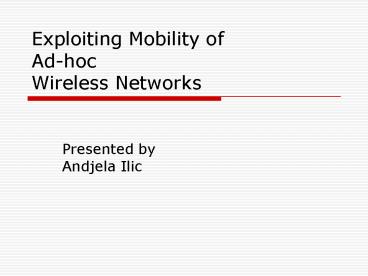Exploiting Mobility of Adhoc Wireless Networks - PowerPoint PPT Presentation
1 / 22
Title:
Exploiting Mobility of Adhoc Wireless Networks
Description:
capacity constrained by the mutual interference of concurrent transmissions. Multiuser diversity ... To overcome interference limitation- find a way for nodes ... – PowerPoint PPT presentation
Number of Views:43
Avg rating:3.0/5.0
Title: Exploiting Mobility of Adhoc Wireless Networks
1
Exploiting Mobility of Ad-hoc Wireless Networks
- Presented by Andjela Ilic
2
Problems treated in the past
- routing, physical layer
- Diversity of time, frequency, space
3
Nobody focused on capacity tillGupta Cumar
- The Capacity of Wireless Networks capacity
constrained by the mutual interference of
concurrent transmissions - Multiuser diversity
4
A couple of ways to observe capacity
- In old-fashioned manner (Shannon)C BW ln( 1
S/N ) - Or, using link rate? BW ln ( 1 P/(NI ))
- Or, regarding performance measuringC Thr /
TX_Rate, whereC - max throughput for a certain
topologyThr no. of bps successfully
transmittedTX_Rate normalization by
corresponding transmission rate
5
Assumption 1
- Random Network -n nodes are iid uniformly
distributed in a disk of unit area - -Each node has a randomly chosen destination
for sending ?(n) bits/sec - -Nodes are homogeneous all transmissions use
the same power
6
Assumption 2
- Physical Model-successful transmission from Xi
to Xj occurs if - P / (Xi Xj)a/ N P / S(Xk Xj)a ß
7
Assumption 3
- n nodes, n S-D pairs,every node is src, dst and
possible relay, at the same time
8
In fixed model (static nodes)
- as n increases -gtgt ?(n) per node decreases
approx as 1/vn, even when optimal scheduling,
routing and relaying is used (Gupta Cumar) - Main perf. limitation is that long-range
communication between many node pairs is
infeasible, due to interference- throughput is
interference limited - comm. allowed just between neighbors, at d1/vn.
- Too much relaying-gtgtuseful throughput small
9
Some definitions
- Throughput time avg of bps that can be
transmitted by each node to its destination - Feasible throughput - throughput ?(n) bps for
every node is feasible if it is possible to
schedule transmissions, such that (with buffering
and multihop fashion) every node can send ?(n)
bps to its destination.
10
Main result of Gupta Cumar
- Lim P?(n) cR / v(nlogn) is feasible1
- Lim P?(n) cR / v(n) is feasible0
- i.e. within the factor of vlogn, ?(n) per node
goes to 0 like R / v(n)
11
BUT
- When mobility is introduced into this model,it
is shown that per node throughput can be kept
constant, as n increases.
12
Mobility, but not relaying
- We assume that nodes will be near, from time to
time - Lim P?(n) cn -1/(1 a/2) R is feasible0
- Available throughput per S-D pair goes to 0 as n
-1/(1 a/2) - If we constrain comm. to nearest neighbors, there
are just small no. of nodes close enough to
communicate- throughput is distance limited
13
Third solution
- To overcome interference limitation- find a way
for nodes to comm. only locally - To overcome distance limitation-network need to
have enough no. of S-D pairs - Solution must do relaying!
14
How it works
- the packets of every S distributed across the
network so each S-D pair always has packets to
send. - nodes independent, stationary and ergodic, it is
sufficient to relay only once! - achievable total throughput is n
- Lim P?(n) cR is feasible1
15
And
- each relay node always has packets to transmit to
its nearest neighbor in steady state, the average
throughput per S-D pair is limited by
interference and achieves constant rate - A two-phase approach is useful
- -Phase 1 Scheduling of pkt transmissions from
sources to relays or destination -Phase 2
Scheduling of pkt transmissions from relays or
source to destinations
16
(No Transcript)
17
Data pkts relayed, FTP, LAR1
18
Data pkts relayed, FTP, LAR11
19
IP pkts traversed over node, CBR
20
Data pkts relayed/node, CBR
21
Receiver E2E delay, CBR
22
Special thanks
- to all of you Patient Listeners












![[AD Hoc Networks] PowerPoint PPT Presentation](https://s3.amazonaws.com/images.powershow.com/8371435.th0.jpg?_=20161231113)


















